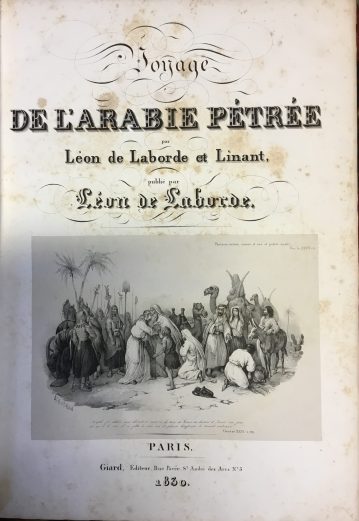Voyage de l’Arabie Pétrée.
Laborde, Simon Joseph Léon Emmanuel, Marquis de.
Synopsis
Archivist, curator, draughtsman and engraver, De Laborde (1807 – 1869) was the son of count (Louis-Joseph-) Alexandre de Laborde and Marie-Anne-Thérèse de Sabatier de Cabre. His family was for generations associated with government public-service appointments. His grandfather, Jean Joseph de Laborde was a Privy Councillor and banker to Louis XV (and guillotined in 1794). Alexandre de Laborde was a Privy Councillor and deputy for the Seine and Oise district. Léon de Laborde’s education also focused on a political career. In 1824 his father lost his assignment and he and his seventeen-year-old son traveled throughout the Middle East, from Damascus to Cairo. There Léon met the engineer Louis Linant de Bellefonds (1799-1883) The two Frenchmen decided to set up an expedition to the newly-discovered site of Petra with a view to making drawings of the monuments. The team of Linant and de Laborde spent more time at the site than any previous Western visitors, documenting the remains through drawings. After his return, De Laborde served as an embassy secretary in Rome, London, and Cassel. In 1830 he published a detailed day-to-day report of his 1828 travel, Voyage de l’Arabie Pétrée, richly illustrated with lithographs of his own drawings as well as a number of those by Linant. It includes various maps and plans, and an introductory essay on different aspects of the region, such as travel, pilgrimage, and trade. An engraver himself, he wrote a study on the history of mezzotint engraving, Histoire de la gravure en manière noire (1839) and another on the discovery of printing, Nouvelles recherches sur la découverte de l’imprimerie (1840). In 1841 he was elected Deputy of the town of Étampes, succeeding his father. He married Louise-Félicie Cousin-Corbin. In 1842 he was elected a member of the Académie des Inscriptions et Belles Lettres. In 1847 he was appointed curator of the Department of Antiquities at the Louvre, and a year later he became the curator of the collections of the Middle Ages and the Renaissance. His research of the archives of Burgundy led to important art historical studies covering the period 1384-1482. Among these, his three-volume publication on the dukes of Burgundy, Les ducs de Bourgogne (1849-1852) deserves to be singled out. His pioneering study on sixteenth-century French Renaissance painting (1850 and 1855), La renaissance des arts à la cour de France, is also based on archival sources. De Laborde was involved in the contemporary art scene, such as the 1851 London World’s Fair and the 1855 Paris Exposition Universelle. In 1857 he was appointed general director of the Archives de l’Empire. In 1868, the year before he died, he became a member of the Senate. A son, Alexandre-Léon-Joseph (1853-1944), was a specialist of illuminated manuscripts.
Laborde is among the first western explorers of the region around Petra. His travelogue Voyage de l’Arabie Pétrée provides a remarkable contribution to the documentation of the archaeological sites of Petra. His archival research was pioneering as well. Louis Courajod (q.v.), who also later held Laborde’s position at the Louvre, maintained a special admiration for De Laborde’s work as curator.
Bibliographic references: Heinz III, 101 f; Gay 3647; Tobler p. 150; Röhricht p. 362 – 3; Schur n° 321; Blackmer n° 929; Labib p. 111 – 15; Brunet, III-714; Vicaire, IV-758.








